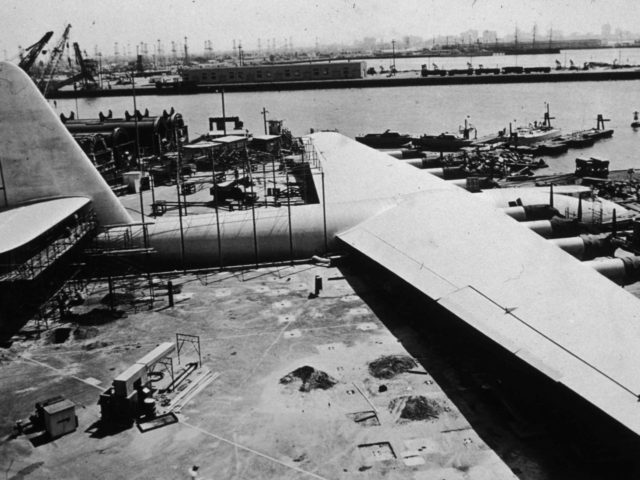A top Silicon Valley venture capitalist is backing a potentially disruptive revolution in huge drone seaplanes for cargo delivery.
The effort evokes the genius of Howard Hughes building the “Spruce Goose” in WWII as the world’s largest freight carrying seaplane.
With U.S. War Department transport of men and materials to the U.K. suffering heavy losses in 1942 due to German U-boats, Howard Hughes was contracted to build the H-4 seaplane. The 218-foot long by 79-foot high amphibious plane, with a 320-foot wingspan and a crew of three, could carry two 30-ton Sherman tanks or 750 fully-equipped soldiers. It could also take off and land on water, and then cruise at a speed 250 miles per hour at an altitude of up to 21,000 feet for 5,000 miles.
Nicknamed the “Spruce Goose,” the Hughes monster seaplane made just one successful demonstration flight, traveling a mile in Los Angeles Harbor on November 2, 1947.
According to SiliconBeat.com, Nautilus Company will complete a 30-foot carbon-fiber scale-model mock-up this summer of a drone version of a mini-“Spruce Goose.” Backed by $750,000 from Tim Draper’s DFJ Venture Capital, Nautilus will conduct seaplane test flights in the north San Francisco Bay.
If the prototype is successful, Nautilus will scale up to an 80-foot operational drone, capable of carrying 40,000 pounds, to start flying cargo from San Francisco to Hawaii in 2019. A year later, the company intends to launch a model that can carry 200,000 pounds to China.
Nautilus states that the current cost for a customer to ship 200,000 lbs. of cargo on an 11-hour flight from L.A. to Shanghai in a Boeing 747 freighter is $260,000. Ocean container shipping can cut the cost by 76 percent, or $199,000, but cargo will not arrive for 21 days. For consumer-driven industries — like fashion and electronics, where styles change rapidly — customers cannot afford to wait for three weeks as trends rise and fade.
Nautilus Company’s website claims that by 2020, its 140-foot drone seaplane with about a 200-foot wingspan will be able to fly 200,000 lbs. of cargo in 30 hours from the Port of San Francisco to the Port of Shanghai for $130,000, assuming aviation fuel costs remain at $3 per gallon.
Nautilus believes it will also save airport infrastructure and national regulatory airspace restriction costs by the drone motoring to at least 12 miles off-shore, flying at low altitudes, and then landing 12 miles off-shore and having a port pilot motor it to its dock.
The company told SiliconBeat that if this summer’s test goes as planned, it will produce a functioning 80-foot drone seaplane in 2019. If that test is successful, Nautilus plans to start building full-sized production units at a cost of $20 million in 2020, under the name “Nemo.”
Not only will the Nemo drone eliminate the Boeing 747-400ER Freighter’s minimum 3-man crew, but its acquisition cost would also be less than 10 percent of the 747’s $238 million price.
But Nemo’s real genius may be saving costs from employing a pair electric jet hybrid engines that would use fuel to power lift-offs, and then use electric power in mid-flight.
Draper told SiliconBeat: “Nautilus presents an extraordinary opportunity in distribution of goods and services without the friction and costs associated with keeping people alive on airplanes.”

COMMENTS
Please let us know if you're having issues with commenting.